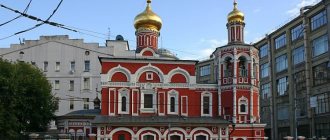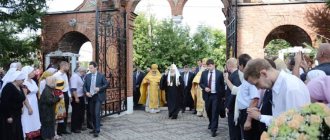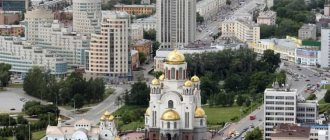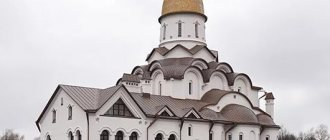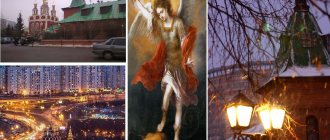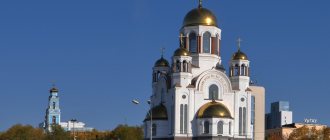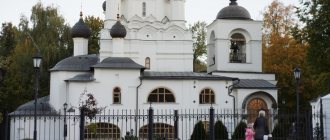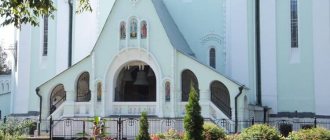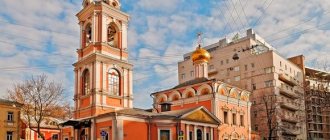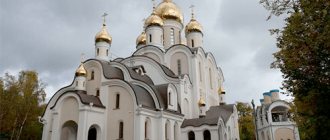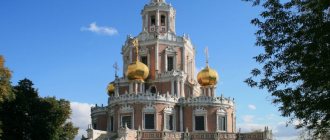Why was Krasnoe Selo, once located near the city walls of Moscow, called “Red”? No, rivers of blood did not flow here (although what corner of our homeland can one say so categorically?), houses were not painted scarlet, and Semyon Mikhailovich Budyonny did not wave his saber. It’s just that since ancient times these places were unusually picturesque, beautiful, “red”, which local residents could not help but note in the name of the settlement. “What a beauty, what a beauty!” Ioann Vasilyevich would have exclaimed if he had passed through Krasnoye Selo, and it is quite likely that this was the case, because the first mention of the settlement appeared a hundred years before the birth of the formidable king. In the 18th century, Krasnoye Selo found itself within the city limits, and in the 19th century, the Alekseevsky nunnery was moved here, which henceforth became, accordingly, Novoalekseevsky, on the territory of which the Church of All Saints - one of the most unusual churches in Moscow. However, first things first!
How to get to the temple?
The easiest way to visit Krasnoye Selo in Moscow and the Church of All Saints itself is to use the metro .
- The metro station closest to the temple is “Krasnoselskaya” (as we can see, the toponymy in this area is very diverse, the main thing is not to get confused).
- From the metro station, move to the left along Krasnoprudnaya Street, pass under the Rusakovskaya overpass, turn left again and move in the given direction until you see a fence made of red (red again!) brick. Voila, you are almost at your goal: on your right hand you will find the entrance to the Alekseevsky Monastery, to which the All Saints Church belongs.
Links
women's Alekseevsky (new) • Rozhdestvensky • Zachatievsky • John the Baptist • Marfo-Mariinsky Convent • Novodevichy • Pokrovsky • Trinity-Odigitrievskaya Hermitage Inactive Extant Andronikov • Krutitskoe • Nikolsky (edinoverie) Partially preserved Epiphany • All Saints (of the same faith) • Georgievsky • Zlatoust • Znamensky • Kazan Golovinsky • Mironositsky • Nikitsky • Nikolo-Greek • Simonov • Skorbyashchensky • Fedorovsky Not preserved Kremlin: Afanasyevsky • Epiphany Troitsky • Voznesensky • Spas on Bor • Chudov
Other: Alekseevsky (old) • Varsonofyevsky • Krestovozdvizhensky • Moiseevsky • Novinsky • StrastnoyHeterodox Catholic Monastery of Saint Francis Old Believers Preobrazhenskaya Old Believer Community
Schedule of services of the Church of All Saints in Krasnoe Selo
The schedule of church services is regularly posted on stands at the entrance to the monastery, in the vestibule of the church itself, and on the official website, so if you need to clarify anything, contact one of these sources of information. In general, the order of services is as follows:
- from Monday to Friday at 6:40 am Matins and Divine Liturgy are served, at 16:40 – Vespers;
- on Saturday from 8:00 - Memorial Service, from 8:30 - Divine Liturgy, from 17:00 - All-Night Vigil;
- on Sunday from 8:00 – Prayer service, from 8:30 – Divine Liturgy, at 16:00 – Vespers and Prayer service, as well as an Akathist before the icon of the Mother of God “The All-Tsarina”.
- On the eve of the great and twelfth holidays, the All-Night Vigil is celebrated.
The fate of the Novo-Alekseevskaya monastery in the 20th century
By the beginning of the last century, the monastery had 4 churches, 42 buildings, a women's school, an almshouse and a hospital. The Alekseevsky monastery was inhabited by more than 70 women of different ages.
The revolution of 1917 radically changed the fate of the monastery. In 1922, church valuables were confiscated from the monastery churches, and two years later most of the nuns were evicted. Some of them remained to live in Moscow apartments, while others moved to the countryside.
Refectory
Then the city authorities closed all the monastery churches and began to liquidate the ancient cemetery, the territory of which was planned to be converted into a park. Local residents recalled with bitterness that relatives were forbidden to carry the ashes of the dead, and marble monuments and tombstones were sold off as building material.
In the early 1930s, an active anti-religious campaign unfolded in the country. The remaining nuns were arrested, convicted and sent into exile to the territory of Kazakhstan and the northern regions of Russia. Then those sisters who lived outside the walls of the monastery were also repressed. Some of them were also sent away from Moscow, while others were shot.
During the years of Soviet power, the Institute of Fisheries, a house of pioneers, an archive and even an enterprise where umbrellas were made were located inside the monastery buildings. In 1979, the hospital Church of the Archangel Michael was demolished and a residential apartment building was built in its place. Then a highway overpass of the Third Transport Ring was laid across the former necropolis, which divided the monastery lands in two.
The former cell building, now a boarding school for the elderly and the Church of Tsarevich Alexei
The monastery in the former Krasnoe Selo began to be revived in the early 1990s. It took a lot of time and money to put the buildings and grounds in order, resume church services and improve the life of the monastic community.
Attractions and shrines of the temple
- Exterior of the temple combines elements characteristic of traditional Russian architecture and romantic motifs. Unique in itself is the three-domed bell tower, adjacent to the temple and giving it a shape reminiscent of the outline of a ship.
- Iconostasis of the temple made of beautiful white marble in Russian-Byzantine style. The painting on the vaults and frescoes made by the masters of the Trinity-Sergius Lavra in a style imitating Byzantine are in amazing harmony with it.
- Near the temple was located the most prestigious in its time necropolis of the Novoalekseevsky monastery, where many outstanding figures found their final refuge: poet A. M. Zhemchuzhnikov, physicist P. N. Lebedev, philanthropist and faithful friend of P. I. Tchaikovsky Nadezhda von Meck, the family of K. S. Stanislavsky and many others. Unfortunately, the necropolis has not survived to this day.
- The temple is famous for its shrines: a list of the icon of the Mother of God “The All-Tsarina” and particles of the relics of Philaret of Moscow , considered a saint, the martyr Tatiana, who suffered for her faith, and Seraphim of Sarov, one of the most revered ascetics of the Orthodox Church.
icon of the Mother of God All-Tsaritsa
relics of Philaret of Moscow
Main structures
Today, the total length of the brick wall surrounding the territory is 870 m. The height of the structures is up to 11 m, the thickness reaches 5 m. 12 towers were built along the perimeter of the walls, 4 corner towers with attached guardhouses are round, the rest have a quadrangular shape. The complex contains 14 different buildings, 8 temples, the rest are of non-religious significance.
Transfiguration Gateway, or Transfiguration Church of the Lord
Located at the main entrance to the monastery. It was built by order of Sophia in 1687-1688, when she was guardian of the heirs to the throne. Consecrated in August 1688. Built in the “Naryshkin Baroque” style, which dominated Moscow architecture until the beginning of the 18th century. Interior architect – K.I. Zolotarev.
The size and magnificent decor, made of white stone, are striking; the structure is crowned with five onion-shaped domes. After the death of Tsar Fyodor, Princess Sophia seriously laid claim to the Russian throne and sought to establish a permanent residence here. Therefore, during her regency she built many new magnificent buildings.
Lopukhin Chambers
Located on the right side of the northern gate. Named in honor of Evdokia Lopukhina. Built in 1688, the former queen lived within their walls from 1727 to 1731. This is a two-story elegant building, built in the “Naryshkin Baroque” style. The facades are decorated with stucco moldings made of snow-white stone, cornices, platbands on the second floor windows, and the remaining parts of the columns - pedestals and capitals.
All architectural decoration is organically combined with the decor of the Transfiguration Cathedral. The oldest sundial in Moscow is installed on the facade. The royal chambers were located on the second floor, and economic services were located on the lower floor. It is interesting that Evdokia Lopukhina was the last Russian tsarina; later Russian autocrats had foreign wives.
Singing chambers
They were built over several years, from 1718 to 1726. This is the largest residential one-story building in the architectural complex - it stretches almost 100 m in length and 15 m in width. At each entrance there is a porch over which an icon hangs. At first the brothers’ cells were located here, then the mentor lived here. In 1724, Peter I ordered the construction of a shelter for foundling girls in the not yet fully completed chambers, who lived here and learned how to weave Brabant lace, for which craftswomen were specially sent from Holland to teach the intricacies of the craft.
They began to call them choir houses in the 19th century, when a new one was built on the site of a destroyed building and choir nuns were settled there. Currently there is a refectory and cells for novices here. Over the many years of its existence, the building has undergone several significant restorations, the last one was carried out in the middle of the last century according to the design of the architect Makarov. During the work, a remarkable discovery was made - a stove with fragments of ancient tiles.
Streletskaya guard
They were intended specifically to house a garrison of archers, who were supposed to guard the monastery territories. The snow-white two-story building was erected in the 17th century in a style typical for such buildings. It has almost no decorative elements; the facade is decorated only with double windows with oval-shaped grilles. When the young tsar suppressed the Streltsy rebellion in 1698, he placed its inspiration, Sophia, for some time in the guardhouse, who was forcibly tonsured as a nun under the name Susanna. Sister Peter's faithful companions were brutally executed in front of her windows in order to break their spirit.
Naprudnaya Tower
Known as Sophia. At the end of the 17th century, the young Tsar Peter I suppressed the Streltsy rebellion, which was organized by his half-sister. To punish the conspirator, he imprisoned her in this gloomy room, in which the princess lived until her death in 1704. The building is also notorious for the fact that Abbess Leonida immured herself and valuable relics in the dungeon beneath it. The abbess did this because the Bolsheviks who seized power wanted to confiscate all the monastic values for the needs of the revolution. There is a belief that if you touch the walls with your left hand (closer to your heart) and make a wish, it will definitely come true.
Assumption Church
Located on the western side of the Smolensk Cathedral. Its construction began in 1685 and lasted almost two years. The building originally belonged to the temple-refectory type, most of which is not directly related to worship. The rest of the space was given over to the community dining room, where novices dined, and on holidays tables were set for honored guests. The refectory has three smaller halls, a vestibule and spacious storage rooms where food prepared for future use was stored.
Mausoleum of Princes Volkonsky
The Mausoleum of Princes Volkonsky or the chapel-tomb of the heroes of the Patriotic War of 1812, Princes Volkonsky, was built in the Empire style. The chapel is small in size and has a cubic shape with a domed roof. The exact date of construction is unknown, presumably in the twenties of the 19th century. Located on the right side of the Assumption Church. It is believed that the mausoleum was designed by the famous Moscow architect of Italian origin Gilardi.
Chambers of Irina Godunova
The two-story building, the construction of which was completed by the middle of the 16th century, is considered the oldest in the architectural ensemble. After the death of Ivan in 1584, the throne passed to Fedora, Irina, his wife, became queen. Godunova played a significant political and social role in the life of the state - she sat in the Duma, received foreign ambassadors, and corresponded with the Queen of England.
On the ninth day after the death of her husband, Tsar Fyodor Ioanovich, Irina, of her own free will, settled in the monastery, took monastic vows and received a new name - Alexandra. Before ascending the throne, his brother lived here, Boris Godunov, whom Alexandra blessed to reign in 1598. Godunova stayed within these walls for 5 years, and after her death she was buried here.
Church of St. Ambrose
The small, single-domed church, built of white stone in the 1560s, was originally dedicated to John the Baptist. Later it was re-consecrated in honor of Ambrose of Milan. The house church was rebuilt several times. The building adjacent to it served at one time as a refectory, until a new community canteen was opened. In 1770, the last major restructuring was carried out by Archbishop Ambrose Zertis-Kamensky. In 1928, the altar of the chapel of St. Nicholas the Wonderworker was built in the refectory. Now there is an exhibition of relics here.
Smolensky Cathedral
Erected by the architect Nestor, who died during construction (according to another version - Aleviz Novy). The building is installed on a white stone basement and has virtually no decoration. A thin arcature belt adorns the three-part apse. It is surrounded by galleries with arched openings, and there are small chapels on both sides. The heads of the cathedral are somewhat shifted to the eastern part, so one compartment is moved forward. The paintings date back to 1526-1530.
The main iconostasis was ordered by Sofya Alekseevna in 1683 - 1868, it was completed by masters of the Armory Chamber. The iconostasis, which was made under the direction of Klim Mikhailov from the city of Shilov, also attracts attention; it is all covered with carvings and gilding. The Orthodox church is magnificent and majestic, considered one of the most beautiful in Moscow.
Gate Church of the Intercession
It was built on the instructions and with the money of Princess Sofia Alekseevna, who by that time was already imprisoned in one of the towers. This majestic three-domed temple with a terrace was built in 1638-1688 above the southern gate, which is currently closed. Red brick was used for construction. Historians believe that architecture combines features of Ukrainian and Russian architectural trends. At the base there is a quadrangle, with a vestibule, an altar and a refectory adjacent to it on the sides. Bell towers were built on two opposite sides. Inside there is an ancient iconostasis with the icon of the “Introduction” (1690).
Mariinsky Chambers
Maria, the sister of Peter I, unlike the wayward Sophia, was quiet, pious and meek, and did not participate in intrigues. But the brother did not like the woman, probably because she maintained friendly relations with her daughter-in-law Evdokia Lopukhina and her conspiratorial sister. This structure was erected especially for Maria - elegant and elegant, for which it received the name “Russian Tower”. According to the original plan, it should be two-story; the third floor appeared much later. Now the administration is located in the “mansion”.
Hospital wards
You can see not far from the Chebotarev Tower, a snow-white two-story building from the mid-17th century. Used as a hospital for soldiers. An apothecary garden was cultivated around the hospital building. On the facade of the building you can see a memorial plaque on which it is written that in 1939 - 1984. The restorer Baranovsky lived here. This man made a great contribution to the restoration of Moscow churches and non-religious buildings.
Bell tower
The bell tower in Baroque style was erected at the end of the 17th century. It was the highest, not counting the belfry of Ivan the Great, which rises 72 meters above the ground. The bell tower is five-tiered, with solid tiers alternating with openwork ones, giving the architecture lightness and grace. Scientists believe that the construction of the bell tower, which began in 1683, was stopped in 1689 after the suppression of the Streltsy revolt. Historians suggest that the belfry must have had at least six tiers.
The architecture consists of octahedrons, as if placed on top of each other. At the very top there is a drum of eight sides, topped with an onion-shaped head. There are two churches on the first and second floors, the bells are on the third and fifth floors. The bell tower is considered one of the masterpieces of Russian architecture.
The building of the Filatievsky School
In 1724, the Tsar ordered the creation of a shelter for foundling girls on the territory of the monastery. They were taught to weave Dutch lace, but the first building did not survive. On the site of the previous premises in 1871-1878. The widow of Privy Councilor V.I. Filatiev organized an orphanage for illegitimate or parentless girls of different classes, called the Filatiev School. In 1899, a parochial school was opened in the classrooms of the school. After the October Revolution, the shelter and school were closed. Currently, the secretariat is located within the walls of the school.
Prokhorov Chapel
The Prokhorov manufacturers built a chapel in 1911-1915 according to the design of the architect V. A. Pokrovsky. Located near the Smolensk Cathedral. The small chapel was erected in the neo-Russian style; funds for this were allocated by the last owner of the manufactory, Nikolai Ivanovich Prokhorov. Nikolai Ivanovich’s father, Ivan Yakovlevich, donated large amounts of money, and besides, Prokhorov’s sister lived within these walls as a nun for a long time.
Treasury chambers
Not far from the Smolensk Cathedral are the oldest Treasury Chambers, which were built, as historians believe, in the last decades of the 17th century and were intended specifically for storing the monastery treasury. Elders and elders lived in these same rooms. In the first half of the 19th century, a wooden mezzanine was added to the one-story building and a portico was added. At the beginning of the 21st century, the facade and interior were completely restored. Behind the house there is a model of the Bogodice-Smolensk architectural ensemble.
Photo of the Church of All Saints in Krasnoe Selo
Krasnoselsky Church of All Saints is “red” at any time of the year.
The parishioners are proud of their temple and especially its unusual “three-headed” bell tower.
This ship is rushing its parishioners into a bright future!
Beginning of the Way of the Cross
The first difficult test in the life of the monastery was the invasion of the Tatars on Moscow in 1451. Among other shrines of the first throne, the barbarians set fire to the Alekseevsky Convent, which after that remained desolate for a long time. Its active revival began during the reign of Grand Duke Vasily III Ioannovich (father of Ivan the Terrible), who commissioned the Italian architect Alivez Fryazin to build a new stone temple of Alexy the Man of God on the site of a burnt wooden church. However, this building was destined for a short life. The creation of the Italian master first suffered in the fire of the Great Moscow Fire of 1547, and then, already in 1571, was finally destroyed during the next Tatar raid.
Church of All Saints in Krasnoe Selo - video
The modern life of the All Saints Church in Krasnoye Selo is full of joyful concerns: it operates an almshouse named after Tsarevich Alexy, parish and Sunday schools, an icon workshop, an Orthodox store with the mysterious name “Arina Rodionovna’s House,” a folk choir and a health camp for children. Since 2013, the monastery has revived its activities around the temple, and several other churches have also been added to it. People seeking peace and solitude come to wander through the quiet garden around the temple.
Whatever your soul craves, in the Krasnoselsky Church of All Saints you will find the beauty of Russian architecture, the peace of a place of worship, and simply joy for the heart.
Excerpt characterizing the Alekseevsky Monastery (Moscow)
Only Kutuzov did not want to understand this and openly expressed his opinion that a new war could not improve the situation and increase the glory of Russia, but could only worsen its position and reduce the highest degree of glory on which, in his opinion, Russia now stood. He tried to prove to the sovereign the impossibility of recruiting new troops; spoke about the difficult situation of the population, about the possibility of failures, etc. In such a mood, the field marshal, naturally, seemed to be only a hindrance and a brake on the upcoming war. To avoid clashes with the old man, a way out was found by itself, which consisted in, as at Austerlitz and as at the beginning of the campaign under Barclay, to remove from under the commander-in-chief, without disturbing him, without announcing to him that the ground of power on which he stood , and transfer it to the sovereign himself. For this purpose, the headquarters was gradually reorganized, and all the significant strength of Kutuzov’s headquarters was destroyed and transferred to the sovereign. Tol, Konovnitsyn, Ermolov - received other appointments. Everyone said loudly that the field marshal had become very weak and was upset about his health. He had to be in poor health in order to transfer his place to the one who took his place. And indeed, his health was poor. Just as naturally, and simply, and gradually, Kutuzov came from Turkey to the treasury chamber of St. Petersburg to collect the militia and then into the army, precisely when he was needed, just as naturally, gradually and simply now, when Kutuzov’s role was played, to take his place a new, needed figure appeared. The war of 1812, in addition to its national significance dear to the Russian heart, should have had another – European one. The movement of peoples from West to East was to be followed by the movement of peoples from East to West, and for this new war a new figure was needed, with different properties and views than Kutuzov, driven by different motives. Alexander the First was as necessary for the movement of peoples from east to west and for the restoration of the borders of peoples as Kutuzov was necessary for the salvation and glory of Russia. Kutuzov did not understand what Europe, balance, Napoleon meant. He couldn't understand it. The representative of the Russian people, after the enemy was destroyed, Russia was liberated and placed at the highest level of its glory, the Russian person, as a Russian, had nothing more to do. The representative of the people's war had no choice but death. And he died. Pierre, as most often happens, felt the full weight of the physical deprivations and stresses experienced in captivity only when these stresses and deprivations ended. After his release from captivity, he came to Orel and on the third day of his arrival, while he was going to Kyiv, he fell ill and lay sick in Orel for three months; As the doctors said, he suffered from bilious fever. Despite the fact that the doctors treated him, bled him and gave him medicine to drink, he still recovered. Everything that happened to Pierre from the time of his liberation until his illness left almost no impression on him. He remembered only grey, gloomy, sometimes rainy, sometimes snowy weather, internal physical melancholy, pain in his legs, in his side; remembered the general impression of misfortune and suffering of people; he remembered the curiosity that disturbed him from the officers and generals who questioned him, his efforts to find a carriage and horses, and, most importantly, he remembered his inability to think and feel at that time. On the day of his release, he saw the corpse of Petya Rostov. On the same day, he learned that Prince Andrei had been alive for more than a month after the Battle of Borodino and had only recently died in Yaroslavl, in the Rostov house. And on the same day, Denisov, who reported this news to Pierre, between conversations mentioned Helen’s death, suggesting that Pierre had known this for a long time. All this seemed strange to Pierre at the time. He felt that he could not understand the meaning of all this news. He was only in a hurry then, as quickly as possible, to leave these places where people were killing each other, to some quiet refuge and there to come to his senses, rest and think about all the strange and new things that he had learned during this time. But as soon as he arrived in Orel, he fell ill. Waking up from his illness, Pierre saw around him his two people who had arrived from Moscow - Terenty and Vaska, and the eldest princess, who, living in Yelets, on Pierre's estate, and having learned about his release and illness, came to him to visit behind him. During his recovery, Pierre only gradually unaccustomed himself to the impressions of the last months that had become familiar to him and got used to the fact that no one would drive him anywhere tomorrow, that no one would take his warm bed away, and that he would probably have lunch, tea, and dinner. But in his dreams, for a long time he saw himself in the same conditions of captivity. Pierre also gradually understood the news that he learned after his release from captivity: the death of Prince Andrei, the death of his wife, the destruction of the French. A joyful feeling of freedom - that complete, inalienable, inherent freedom of man, the consciousness of which he first experienced at his first rest stop, when leaving Moscow, filled Pierre's soul during his recovery. He was surprised that this internal freedom, independent of external circumstances, now seemed to be abundantly, luxuriously furnished with external freedom. He was alone in a strange city, without acquaintances. Nobody demanded anything from him; they didn’t send him anywhere. He had everything he wanted; The thought of his wife that had always tormented him before was no longer there, since she no longer existed.
Period of Napoleonic invasion
In 1812, when French troops captured Moscow, the Alekseevsky Monastery suffered the same bitter fate as most other monasteries. It was completely looted and partially burned. Miraculously, only the main temple and several outbuildings survived. The sisters and the abbess, Abbess Anfisa (Kozlova), managed to escape only due to the fact that they were evacuated a few days before the invaders entered the city.
After the expulsion of Napoleonic troops from Russian territory, Emperor Alexander I made a vow in gratitude to God to build a temple in Moscow dedicated to Christ the Savior. The search for a place for its construction is associated with another, and this time the last, transfer of the Alekseevskaya convent to a new location.
Under the patronage of the royal family
From now on, the monastery enjoyed special attention from members of the royal family, who regularly made generous donations and cared about the well-being of the nuns. One of the most famous nuns of that period was the wife of the future Patriarch Nikon (the culprit of the church schism), whom he assigned there after he decided to take monastic vows. Princess Urusova, the sister of the famous schismatic noblewoman Morozova, was also kept in custody there.
